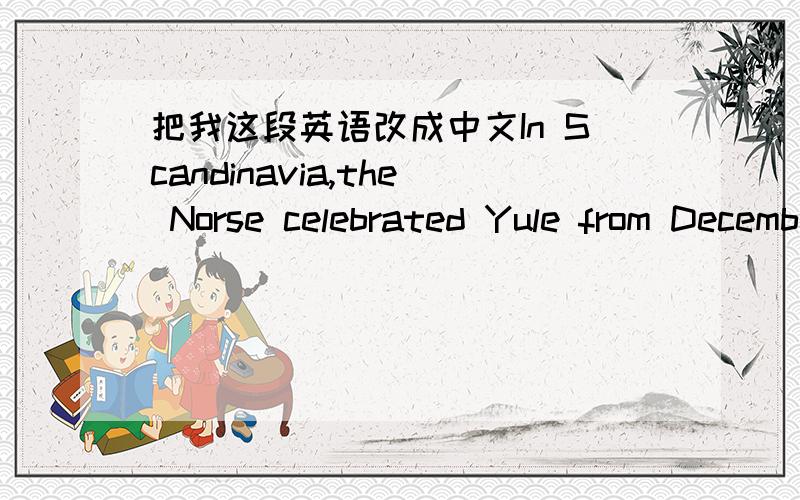把我这段英语改成中文In Scandinavia,the Norse celebrated Yule from December 21,the winter solstice,through January.In recognition of the return of the sun,fathers and sons would bring home large logs,which they would set on fire.The people w
来源:学生作业帮助网 编辑:作业帮 时间:2024/04/20 05:09:27

把我这段英语改成中文In Scandinavia,the Norse celebrated Yule from December 21,the winter solstice,through January.In recognition of the return of the sun,fathers and sons would bring home large logs,which they would set on fire.The people w
把我这段英语改成中文
In Scandinavia,the Norse celebrated Yule from December 21,the winter solstice,through January.In recognition of the return of the sun,fathers and sons would bring home large logs,which they would set on fire.The people would feast until the log burned out,which could take as many as 12 days.The Norse believed that each spark from the fire represented a new pig or calf that would be born during the coming year.
把我这段英语改成中文In Scandinavia,the Norse celebrated Yule from December 21,the winter solstice,through January.In recognition of the return of the sun,fathers and sons would bring home large logs,which they would set on fire.The people w
在斯堪的纳维亚,人们从12月21日冬至开始庆祝耶诞季节,一直到1月份.
感受到太阳的回归后,父亲和儿子们会把大型圆木带回家,然后点燃.人们一直狂欢设宴,直到圆木燃尽,这往往需要花上12天.斯堪的纳维亚人相信,火中生出的每颗火花都代表来年将会诞生的猪仔或小牛.
In Scandinavia, the Norse celebrated Yule from December 21, the winter solstice, through January. In recognition of the return of the sun, fathers and sons would bring home large logs, which they woul...
全部展开
In Scandinavia, the Norse celebrated Yule from December 21, the winter solstice, through January. In recognition of the return of the sun, fathers and sons would bring home large logs, which they would set on fire. The people would feast until the log burned out, which could take as many as 12 days. The Norse believed that each spark from the fire represented a new pig or calf that would be born during the coming year.
收起
在斯堪的纳维亚,挪威人庆祝圣诞节从12月21日冬至日起,一直到1月。在认出太阳的回归后,父亲们和儿子们把用来生火的圆木带回家。人们举办宴会,直到圆木燃尽,这将持续12天之久。挪威人相信火焰中的每一个火星,象征着来年将会出生的一头小猪或小牛。...
全部展开
在斯堪的纳维亚,挪威人庆祝圣诞节从12月21日冬至日起,一直到1月。在认出太阳的回归后,父亲们和儿子们把用来生火的圆木带回家。人们举办宴会,直到圆木燃尽,这将持续12天之久。挪威人相信火焰中的每一个火星,象征着来年将会出生的一头小猪或小牛。
收起
在斯堪的纳维亚,挪威人从12月21日的冬至日开始庆祝圣诞节,一直到一月份过去才结束。在日照回归的那天,挪威的男人们会搬一块大木头回家,放在火里烧。人们会不停举办宴会,直到这块木头烧完为止,整个过程可能长达12天。挪威人认为,火堆的每一个火花都表示来年即将诞生的一头小猪或者小牛。...
全部展开
在斯堪的纳维亚,挪威人从12月21日的冬至日开始庆祝圣诞节,一直到一月份过去才结束。在日照回归的那天,挪威的男人们会搬一块大木头回家,放在火里烧。人们会不停举办宴会,直到这块木头烧完为止,整个过程可能长达12天。挪威人认为,火堆的每一个火花都表示来年即将诞生的一头小猪或者小牛。
收起
在斯堪的纳维亚,挪威人从 12月21日,冬至那天开始庆祝圣诞节,直到1月底。在确认太阳的回归,父亲和儿子们都会给把大木头带返家中燃烧。人们会吃喝庆祝,直到木头烧尽,这可能需要多达 12天。挪威人认为,燃烧的木头所发出的每个火点,都代表著来年会有一只小猪或小牛出生。...
全部展开
在斯堪的纳维亚,挪威人从 12月21日,冬至那天开始庆祝圣诞节,直到1月底。在确认太阳的回归,父亲和儿子们都会给把大木头带返家中燃烧。人们会吃喝庆祝,直到木头烧尽,这可能需要多达 12天。挪威人认为,燃烧的木头所发出的每个火点,都代表著来年会有一只小猪或小牛出生。
收起
在斯堪的那维亚半岛,挪威人从12月21日冬至日开始庆祝圣诞节直到1月。
为了酬答阳光的重返,父亲们和孩子们会将大块的木材带回家中用来生火。
人们盛宴庆祝,直至木头烧完,时间长达12天之久。挪威人相信每个从火中跳出的火花代表了将会在来年出生的一只的猪或一头牛。
是我自己翻译的哦,敬请放心借鉴!...
全部展开
在斯堪的那维亚半岛,挪威人从12月21日冬至日开始庆祝圣诞节直到1月。
为了酬答阳光的重返,父亲们和孩子们会将大块的木材带回家中用来生火。
人们盛宴庆祝,直至木头烧完,时间长达12天之久。挪威人相信每个从火中跳出的火花代表了将会在来年出生的一只的猪或一头牛。
是我自己翻译的哦,敬请放心借鉴!
收起
手翻的,意思应该是对的。
在斯堪的纳维亚半岛,挪威人每年从12月21日,也就是冬至日来临之际开始庆祝圣诞,直到一月底。在那些天,当太阳快下山的时候,父亲和小孩会把大棵的木材扛回家中。他们拿这些木材来燃炉。前后大约要燃上整整12天。等这些木头燃尽成灰,人们也已经把美食享用得差不多了。挪威人相信每一朵火苗,每一片火花都意味着来年会多添一头小猪仔或者小牛犊。...
全部展开
手翻的,意思应该是对的。
在斯堪的纳维亚半岛,挪威人每年从12月21日,也就是冬至日来临之际开始庆祝圣诞,直到一月底。在那些天,当太阳快下山的时候,父亲和小孩会把大棵的木材扛回家中。他们拿这些木材来燃炉。前后大约要燃上整整12天。等这些木头燃尽成灰,人们也已经把美食享用得差不多了。挪威人相信每一朵火苗,每一片火花都意味着来年会多添一头小猪仔或者小牛犊。
收起